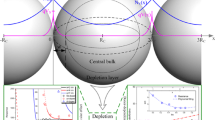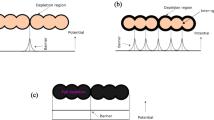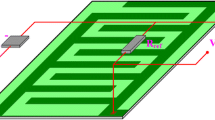Abstract
The model of gradient-distributed oxygen vacancies is utilized in simulating the grain size effects of gas-sensitive SnO2 thin films. The distribution profile of oxygen vacancies has a grain size effect and the profile gradient correlates positively with the radius of the grains. The simulation results show that the grain size is a fundamental factor dominating the gas-sensing properties of thin films. The potential barrier height and resistivity have significant grain size effects when m is between 0.1 and 0.5 nm-1. The size effects on sensor response to stimulant gases can be enhanced by increasing the value of m or the absolute value of a. Two expressions are used to simulate the grain size effect of the sensor response. The expressions act similarly when a < 0.2. The simplified response provides a neat function to quantitatively explain the sensor performance on gases with low partial pressure. Although the accurate response is complicated, it is applicable to the entire concentration range. A small power-law exponent n is calculated from the accurate response expression when a high gas concentration is employed, illustrating a “saturation effect” of the response.
Similar content being viewed by others
References
T. Seiyama, A. Kato, K. Fujiishi, and M. Nagatani, Anal. Chem. 34, 1502 (1962).
T. Seiyama and S. Kagawa, Anal. Chem. 38, 1069 (1966).
G. Korotcenkov, V. Brinzari, Y. Boris, M. Ivanov, J. Schwank, and J. Morante, Thin Solid Films 436, 119 (2003).
G. Khuspe, S. Navale, D. Bandgar, R. Sakhare, M. Chougule, and V. Patil, Electron. Mater. Lett. 10, 191 (2014).
K. K. Khun, A. Mahajan, and R. Bedi, Electron. Mater. Lett. 7, 303 (2011).
J. D. Prades, R. Jimenez-Diaz, F. Hernandez-Ramirez, S. Barth, A. Cirera, A. Romano-Rodriguez, S. Mathur, and J. R. Morante, Sensor. Actuat. B-Chem. 140, 337 (2009).
V. Kumar, S. Sen, K. P. Muthe, N. K. Gaur, S. K. Gupta, and J. V. Yakhmi, Sensor. Actuat. B-Chem. 138, 587 (2009).
G. X. Wang, J. S. Park, M. S. Park, and X. L. Gou, Sensor. Actuat. B-Chem. 131, 313 (2008).
H.-S. Hong and C.-O. Park, Electron. Mater. Lett. 1, 11 (2005).
H. G. Moon, H. W. Jang, J.-S. Kim, H.-H. Park, and S.-J. Yoon, Electron. Mater. Lett. 6, 135 (2010).
B.-J. Kim, I.-G. Song, and J.-S. Kim, Electron. Mater. Lett. 10, 509 (2014).
S. R. Morrison, Sensor. Actuat 12, 425 (1987).
N. Yamazoe, J. Fuchigami, M. Kishikawa, and T. Seiyama, Surf. Sci. 86, 335 (1979).
N. Yamazoe and K. Shimanoe, Sensor. Actuat. B-Chem. 128, 566 (2008).
S. R. Morrison, Sensor. Actuat 11, 283 (1987).
N. Yamazoe and K. Shimanoe, Sensor. Actuat. B-Chem. 138, 100 (2009).
G. Sakai, N. Matsunaga, K. Shimanoe, and N. Yamazoe, Sensor. Actuat. B-Chem. 80, 125 (2001).
N. Matsunaga, G. Sakai, K. Shimanoe, and N. Yamazoe, Sensor. Actuat. B-Chem. 83, 216 (2002).
J. Liu, S. Gong, J. Xia, L. Quan, H. Liu, and D. Zhou, Sensor. Actuat. B-Chem. 138, 289 (2009).
S. Gong, J. Liu, J. Xia, L. Quan, H. Liu, and D. Zhou, Mater. Sci. Eng. B-Adv. 164, 85 (2009).
N. Yamazoe, K. Shimanoe, and C. Sawada, Thin Solid Films 515, 8302 (2007).
C. Xu, J. Tamaki, N. Miura, and N. Yamazoe, Sensor. Actuat. B-Chem. 3, 147 (1991).
J. Liu, S. Gong, L. Quan, Z. Deng, H. Liu, and D. Zhou, Sensor. Actuat. B-Chem. 145, 657 (2010).
J. Liu, S. Gong, Q. Fu, Y. Wang, L. Quan, Z. Deng, B. Chen, and D. Zhou, Sensor. Actuat. B-Chem. 150, 330 (2010).
C. Malagù, V. Guidi, M. Stefancich, M. C. Carotta, and G. Martinelli, J. Appl. Phys. 91, 808 (2002).
C. Fonstad and R. Rediker, J. Appl. Phys. 42, 2911 (1971).
S. Samson and C. Fonstad, J. Appl. Phys. 44, 4618 (1973).
H. Liu, S. Gong, Y. Hu, J. Liu, and D. Zhou, Sensor. Actuat. B-Chem. 140, 190 (2009).
S. M. Sze, Semiconductor Devices: Physics and Technology, John Willey & Sons, Inc. (2009).
Author information
Authors and Affiliations
Corresponding author
Rights and permissions
About this article
Cite this article
Liu, J., Zhai, Z., Jin, G. et al. Simulation of the grain size effect in gas-sensitive SnO2 thin films using the oxygen vacancy gradient distribution model. Electron. Mater. Lett. 11, 34–40 (2015). https://doi.org/10.1007/s13391-014-4176-5
Received:
Accepted:
Published:
Issue Date:
DOI: https://doi.org/10.1007/s13391-014-4176-5




